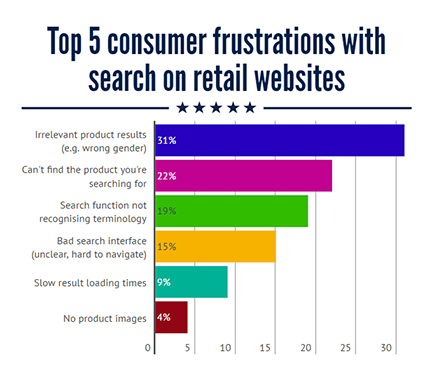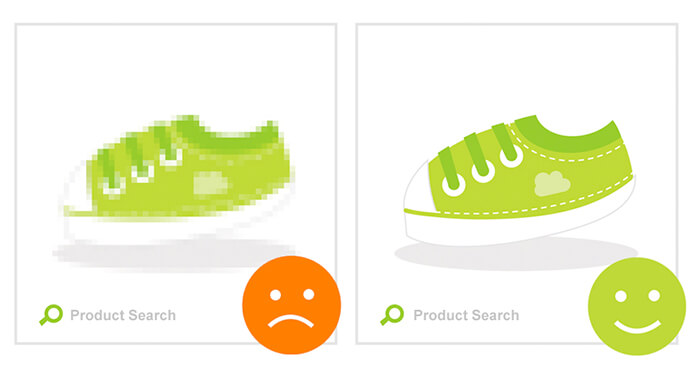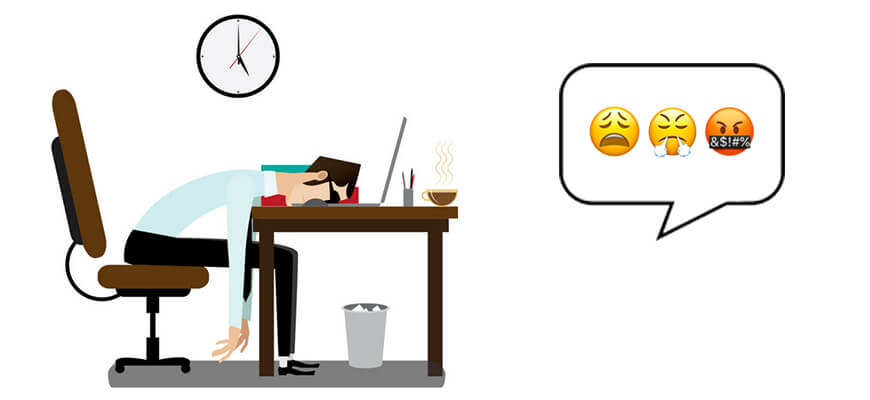9 Mistakes Turning Customers Off Your E-commerce Site

The eCommerce has been expanding exponentially over recent years. But nowadays, experienced online buyers are looking not only for products but for a well-organized shopping experience. And even one small error therein can turn out to shopping cart abandonment.
That's why, while optimizing an eCommerce website, it’s important to avoid the mistakes, mentioned below to improve conversions, maximize your revenue and provide worthwhile shopping experience.
1. Slow Loading Pages
As it’s important for retail stores to have a fast moving checkout line, similarly it’s important for an eCommerce website that its pages load faster.
| “A 1-second delay in page response can result in a 7% reduction in conversions.” – Kissmetrics
Slow website speed will not only affect the user experience but also affect your search engines ranking. Easy navigation and friendly interface are important, but if your site loads slowly than your site visitor will leave it without surfing anything further. So, higher the loading time, higher the bounce rate.
2. No Mobile Optimization
| “If your plans don’t include mobile, your plans are not finished.” – Wendy Clarke, Coca-Cola

Are we still living in the world of desktop users? No longer. We're living in a mobile world. Nowadays, transactions are taking place on tablets and smartphones at an alarming rate. M-commerce is on the increase, what makes it imperative that you have either device-agnostic or mobile-optimized website. According to Statista, the projected transaction value of global M-commerce sales is rising at an accelerating pace is expected to run to the $693.39 billion mark in 2019.
Always remember that your site will be visited by mobile users and make it more mobile-friendly accordingly with appropriately sized buttons, good text/image balance, etc.
It is no longer a best practice to let your site visitors choose between your regular desktop site and the mobile one. One site should work just as well on all screens and devices.
| “78% of mobile device users claim that the “look and feel” of a company’s mobile site has a huge impact on their decision to make a purchase from it.”
Not mobile-optimized eCommerce sites are surely overlooking a ton of eventual sales.
3. No SEO Strategy
How are people going to find you on the World wide web? They are likely to search for the company/product using one of the top search engines like Google. Search engine optimization is about more than only keywords; it's also about how the site is built, what data is parsed, how images are tagged and many other things.
4. Obscure Navigation
There are no too many things that can discourage a customer quicker than poor navigation. Lack of buttons, too many colors and font types, hard-to-find information and other mistakes usually the most frequently lead to customer frustration and no sales. Your eCommerce site is set to be easy to navigate.
Customers should be able to get enough product info, to click on images on the product page, to be able to go back to the homepage using back button or breadcrumbs. When it comes to the site’s navigation, don’t reinvent the wheel — just use the navigation best practices to get the most out of your site.
a. Inadequate Search Capability

Source: RichRelevance
Customers expect to be able to find what they're looking for quickly and easily. It's good practice to make your site search box stand out, ensure it can handle long tail semantic searches and enable autocomplete.
| According to Andy Eades of Elevate Web, customers who use on-site search to find a product are three times more likely to purchase.
At the same time, make sure you have optimized your product descriptions with keywords and tags as well for better Search Engine Optimization.
b. Puzzling Category Structure 
c. Indigested CTAs (call-to-action)
Call-to-action (CTA) buttons play an essential role in increasing sales by catching your customer’s attention. CTAs help to guide customers on what to do next on site.
Customers need encouragement to take the action you want them to. To your visitors, an eCommerce site with poor CTAs is like being sent on a scavenger hunt with no clues — they simply lose interest and find something else to do.
The most frequent mistake of eCommerce sites is including far too many CTAs on every page, what frequently only confuses visitors. The fundamental aim of each eCommerce website is to make sales, so their main CTA is to be sales-centric.
Thus, you always have to make sure that the way you’ve written your CTAs and the text surrounding it is optimized for conversions. If they're not - follow this Call-to-action button ultimate guide.
But your conversions are never going to be what you want them to be unless your CTAs are intriguing and interesting enough to make your website visitor think “Aww yeah, I want it right NOW”. That's why having a handful of little-known CTA hacks in your sleeve can make a big difference.
d. Product Page
Playing a key role in the conversion process, the product pages are the most important pages for the eCommerce websites. Product page design should be attractive and clean, telling your shoppers why to buy from you, not from your competitors.
a. Product Images.

Product images are the only one way for online store visitors to understand what they are really buying. That's why you should suggest multiple product shots and from multiple angles preferably. If the product comes in various colors, you are highly recommended to include images of those options too.
b. Descriptions.
They are no less important than the product images. The product description should cover all of the selling points as well as answer the questions on how the product is made, how it works or what it does. Having only the manufacturer description isn’t enough. Unique description will tell customers why they should buy the product. If possible, include a list of the materials the product is made of, any manufacturing techniques or processes, warranty info, so on.
c. Stock availability.
Showing stock availability on your site is likely to save your customers from heartbreak when the product is revealed to be out of stock when they hit the checkout page. And it also creates a sense of urgency that can drive conversion rates up.
e. Insufficient Checkout
Even if you offer the best quality and value on the market, and the rest of your site is a dream to navigate, you will fall at the final hurdle unless your checkout process is secure and quick and simple to use. There are many things, driving your customers away at checkout.
Make certain to offer an option to check out as a guest for those customers who don’t want to create an account – don’t have to. It is critical to have one screen check-out process if possible, because of being faster and less confusing for shoppers, one-page checkout may increase conversions. To reduce shopping cart abandonment, you should get shoppers to pull the trigger right away on making a purchase instead of relying on them to come back later to finish a multi-step checkout process.
5. Lack of Shipping Methods

All consumers prefer to have options, and this is especially true for shipping. Try to do your best to suggest a variety of methods of shipment in terms of price and delivery time.
6. Incomplete Contact Info

Even if someone doesn’t plan on reaching out to your company, having complete contact information helps people trust a business.
Simply listing a phone number or email address isn’t enough. It is a best practice to list phone number, email address, and legal physical address on the contact us page.
7. No Social Media Presence

It’s almost impossible to run an online business in 2018 and without using social media. And this is particularly true for eCommerce. Thus, make sure there are social sharing and follow buttons on every product page.
Social networks are the number one choice of online media that survey respondents use to find inspiration for their purchases. [PwC’s Global Consumer Insights Survey]
Also, social media is an important customer service strategy for eCommerce companies. Customers nowadays expect a quick response on social media and are using it as a medium to give quick feedback.
Social media integrated into your website give your shoppers the opportunity to share your products via their social profiles. This is a great way to increase the visibility of your offerings and attract new business.
8. No Customer Support

One of the biggest reasons for most visitors leaving an eCommerce site without buying anything is that they don’t know whom to ask if they need any information. That's why one of the very first things that you need to concentrate on an eCommerce business is customer service.
Your consumers should find it easy to get their questions answered, speak to a person (if they prefer) or file a complaint without any inconvenience. You should be also ready to take returns and process a variety of payment and also include refunds if it is necessary.
Moreover, you have to incorporate positive emotion into the customer experience, as the most powerful indicator and at the same time driver of customer loyalty is how a customer feels about an interaction with a company.
Those who have a positive emotional experience are 6 times more likely to purchase again and 12 times more likely to recommend a company in comparison to those with poor emotional experience.
9. Ignoring Abandoned Carts

eCommerce visitors normally don’t buy on their first visit. So, retargeting is extremely important for an eCommerce business and a great means for shopping cart recovery.
| 69% of all eCommerce visitors abandon their shopping cart.
All is not lost if you lose a sale — it's possible to re-engage with a customer and entice them back to your site to complete their transaction.
Retailers are doing this through a number of ways, including personalizing the offer for a limited time period to increase their conversions. Also, retargeting can be used to bring back customers who have earlier done shopping on your site.
Conclusion
These are only some of the eCommerce mistakes that irritate online shoppers. So, if your store has some of the issues above mentioned, it is high time you sort them out to provide your users with the best experience.
Do you know about other essential mistakes that turn away customers from making a purchase decision? Share them with us.
